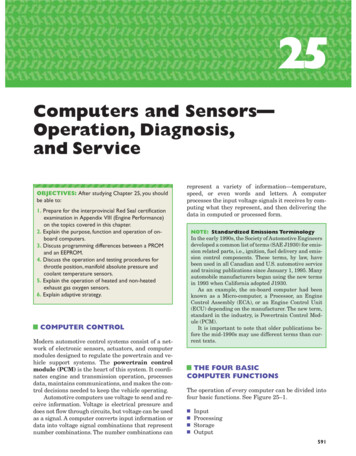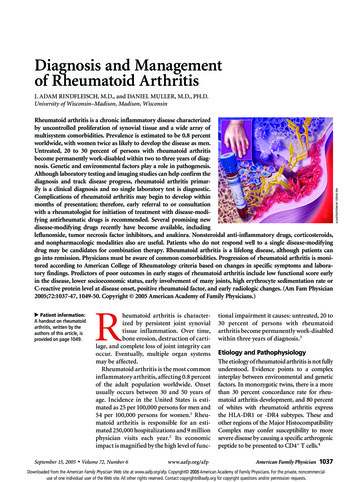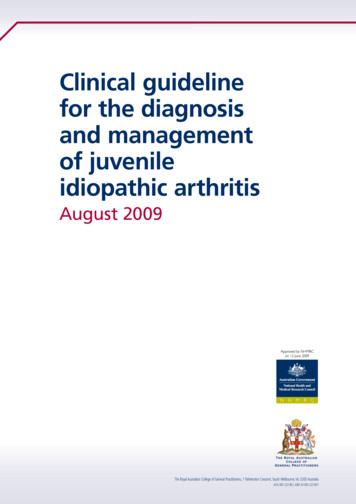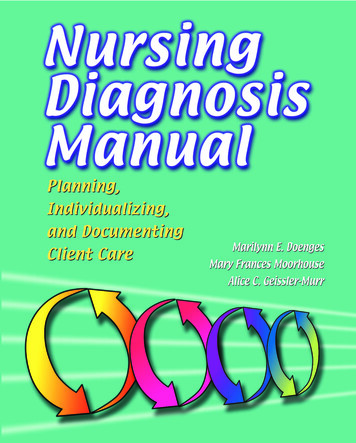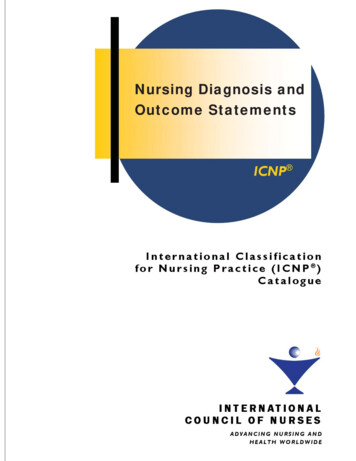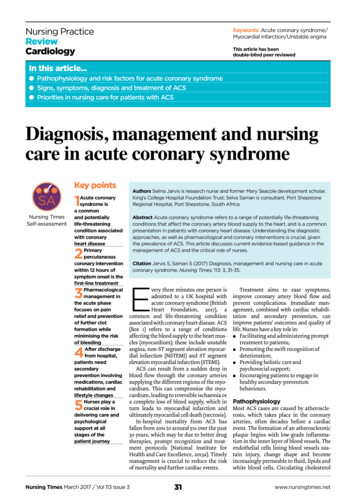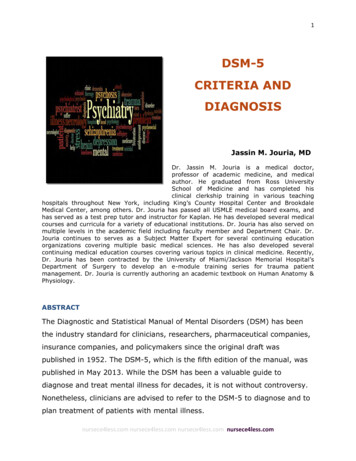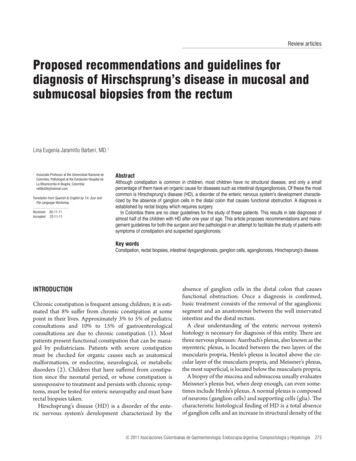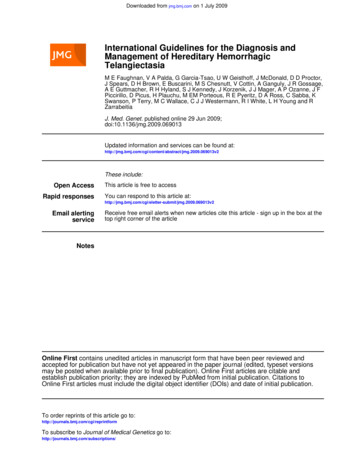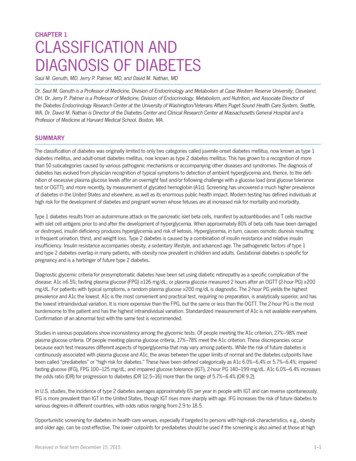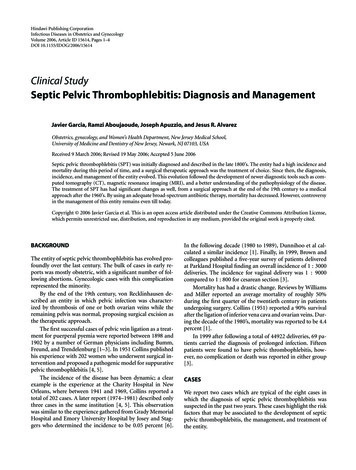
Transcription
Hindawi Publishing CorporationInfectious Diseases in Obstetrics and GynecologyVolume 2006, Article ID 15614, Pages 1–4DOI 10.1155/IDOG/2006/15614Clinical StudySeptic Pelvic Thrombophlebitis: Diagnosis and ManagementJavier Garcia, Ramzi Aboujaoude, Joseph Apuzzio, and Jesus R. AlvarezObstetrics, gynecology, and Women’s Health Department, New Jersey Medical School,University of Medicine and Dentistry of New Jersey, Newark, NJ 07103, USAReceived 9 March 2006; Revised 19 May 2006; Accepted 5 June 2006Septic pelvic thrombophlebitis (SPT) was initially diagnosed and described in the late 1800’s. The entity had a high incidence andmortality during this period of time, and a surgical therapeutic approach was the treatment of choice. Since then, the diagnosis,incidence, and management of the entity evolved. This evolution followed the development of newer diagnostic tools such as computed tomography (CT), magnetic resonance imaging (MRI), and a better understanding of the pathophysiology of the disease.The treatment of SPT has had significant changes as well, from a surgical approach at the end of the 19th century to a medicalapproach after the 1960’s. By using an adequate broad-spectrum antibiotic therapy, mortality has decreased. However, controversyin the management of this entity remains even till today.Copyright 2006 Javier Garcia et al. This is an open access article distributed under the Creative Commons Attribution License,which permits unrestricted use, distribution, and reproduction in any medium, provided the original work is properly cited.BACKGROUNDThe entity of septic pelvic thrombophlebitis has evolved profoundly over the last century. The bulk of cases in early reports was mostly obstetric, with a significant number of following abortions. Gynecologic cases with this complicationrepresented the minority.By the end of the 19th century, von Recklinhausen described an entity in which pelvic infection was characterized by thrombosis of one or both ovarian veins while theremaining pelvis was normal, proposing surgical excision asthe therapeutic approach.The first successful cases of pelvic vein ligation as a treatment for puerperal pyemia were reported between 1898 and1902 by a number of German physicians including Bumm,Freund, and Trendelenburg [1–3]. In 1951 Collins publishedhis experience with 202 women who underwent surgical intervention and proposed a pathogenic model for suppurativepelvic thrombophlebitis [4, 5].The incidence of the disease has been dynamic; a clearexample is the experience at the Charity Hospital in NewOrleans, where between 1941 and 1969, Collins reported atotal of 202 cases. A later report (1974–1981) described onlythree cases in the same institution [4, 5]. This observationwas similar to the experience gathered from Grady MemorialHospital and Emory University Hospital by Josey and Staggers who determined the incidence to be 0.05 percent [6].In the following decade (1980 to 1989), Dunnihoo et al calculated a similar incidence [1]. Finally, in 1999, Brown andcolleagues published a five-year survey of patients deliveredat Parkland Hospital finding an overall incidence of 1 : 3000deliveries. The incidence for vaginal delivery was 1 : 9000compared to 1 : 800 for cesarean section [3].Mortality has had a drastic change. Reviews by Williamsand Miller reported an average mortality of roughly 50%during the first quarter of the twentieth century in patientsundergoing surgery. Collins (1951) reported a 90% survivalafter the ligation of inferior vena cava and ovarian veins. During the decade of the 1980’s, mortality was reported to be 4.4percent [1].In 1999 after following a total of 44922 deliveries, 69 patients carried the diagnosis of prolonged infection. Fifteenpatients were found to have pelvic thrombophlebitis, however, no complication or death was reported in either group[3].CASESWe report two cases which are typical of the eight cases inwhich the diagnosis of septic pelvic thrombophlebitis wassuspected in the past two years. These cases highlight the riskfactors that may be associated to the development of septicpelvic thrombophlebitis, the management, and treatment ofthe entity.
2Case 1A 28-year-old primigravid underwent a cesarean section secondary to having a breech presentation and rupture of membranes at 36 weeks gestation. The cesarean section was uncomplicated, but on postpartum day one the patient was having fever and uterine tenderness. A diagnosis of postpartumendometritis was made and the infection was treated with Ertapenem 1 g intravenously daily. After 48 hours of antibiotics,the patient denied uterine tenderness and her WBC countwas 12000/mm3 . Nevertheless, the patient continued to spikefevers and on postpartum day four an abdominal CT scanwas obtained. A right ovarian vein thrombosis was noted onthe imaging and the patient started therapeutic enoxaparin.After 48 hours of anticoagulation, the patient was afebrileand asymptomatic. The patient was discharged home afterbeing anticoagulated with warfarin and after 6 weeks a CTscan was repeated. The right ovarian thrombosis was notpresent in the images and warfarin was discontinued.Case 2A 32-year-old patient underwent a successful in vitro fertilization. At 25 weeks gestation the patient had preterm premature rupture of membranes. The patient was started onpenicillin G and a course of steroids was given. After 1 weekof expectant management, the patient started to have contractions and a diagnostic amniocentesis was performed. Anintraamniotic infection was diagnosed and a classical cesarean section was performed. The patient was started ongentamicin and clindamycin intraoperatively. After 24 hoursof antibiotics, the patient continued to have fever and ampicillin was added. On postpartum day 4, the patient complained of pelvic pain and continued to have fever spikesto 101 F. The patient’s urinalysis, urine, and blood cultureswere negative and her WBC count was 17000/mm3 . Thepatient was anticoagulated with enoxaparin after a clinicaldiagnosis of septic pelvic thrombophlebitis that was suspected and an abdominal CT scan was ordered. The CTscan was negative, but after 24 hours of enoxaparin, the patient became afebrile and her pelvic pain diminished. After2 days with enoxaparin a WBC count was repeated showing a decrease to 12000/mm3 . The patient was dischargedhome on enoxaparin for another week and was followed inclinic for her postoperative appointment. Her pelvic painwas minimal and the rest of her recovery was uncomplicated.PathophysiologyThe pathophysiology of pelvic thrombophlebitis as a progression of a pelvic infection was first elucidated by Collinsand later Duff, Gibbs, and others [1, 4, 5].The pathogenesis is thought to include injury to the intima of the pelvic vein caused by a spreading uterine infection, bacteremia, and endotoxins, which can also occur secondary to the trauma of delivery or surgery. In this setting,Virchow’s triad is completed due to the contribution of preg-Infectious Diseases in Obstetrics and Gynecologynancy as a well-known hypercoagulable state, and the reduction of blood flow in dilated uterine and ovarian veins duringthe postpartum period which causes venous stasis. Phlebographic studies have demonstrated a left to right venous flowin upright position, which may explain the dextro-prevalenceof ovarian vein thrombosis [1].Diagnostic approachA suspicion of SPT should arise when fever, which usuallyfollows a spiking pattern, fails to respond to standard broadspectrum antibiotic therapy. Septic pelvic thrombophlebitiswas diagnosed in 20 percent of patients with prolongedfebrile morbidity, defined as more than five days of fever regardless of appropriate antimicrobial treatment [3].Patients often complain of flank and lower abdominalpain, typically described as noncolicky and constant. Painmay be of variable intensity and may radiate to the groin orupper abdomen, and paralytic ileus may occur.Upon physical examination, the patient usually does notappear toxic, there may be tenderness to palpation in thelower abdomen, and an occasional tender abdominal massdescribed as rope or sausage-shape may be identified. Thisrepresents the most diagnostic finding in an abdominalexam, but it is rare.Other clinical characteristics of septic pelvic thrombophlebitis have changed over time. Pulmonary emboli, wasconsidered a criterion for diagnosis of the condition. Initialreports described pulmonary embolic phenomena to be frequent, small, and multiple [4, 5, 7].During the decades of the 1960’s through 1970’s, someauthors reported that 32 to 38 percent of patients with septicpelvic thrombophlebitis had evidence of pulmonary emboli[7]. Most of these diagnoses were made only on the basis ofradiographic findings. However, other contemporary investigators demonstrated an incidence of pulmonary embolismin a range of 2.7%. The latest series (1999) did not report asingle embolic event after following up 44922 patients over a3-year period [3]. Refinements in the diagnostic methodology as well as implementation of earlier and more effectivetreatment are likely the reasons responsible for the remarkable decline in the incidence of embolic events.Diagnostic tools like computed tomography (CT) andmagnetic resonance imaging (MRI) are used to provide confirmation of pelvic thrombophlebitis [1]. Tomographic criteria for diagnosis include (1) enlargement of the vein involved,(2) low density lumen within the vessel wall, and (3) sharpenhancement of the vessel wall. When using MRI the thrombosed vessel will appear bright whereas normal blood flowlooks dark.It is believed that both methods are comparable. MRI offers a better visualization of soft tissue changes, being ableto evaluate the resolution of edema and inflammatory signs.However, both techniques have their limitations related to visualizing smaller vessels such as uterine, cervical, and othersmaller pelvic branches.Anecdotal experiences with pelvic ultrasound used forthe diagnosis of ovarian vein thrombosis revealed a limited
Javier Garcia et al3Table 1: Diagnosis and management for presumed septic pelvic thrombophlebitis.CT or MRI findingsAntibioticsAnticoagulationLength of treatmentFinal outcomeRight ovarianvein thrombosisErtapenem orgentamicin,ampicillin,clindamycin(7 days)Enoxaparin (1 mg/Kg),warfarin (INR 2.5)3–6 months warfarinRepeat CT scanafter 3 months.If negative, stopanticoagulation.If still positivefor thrombi,anticoagulatefor 3 additionalmonthsPelvic branchvein thrombosisErtapenem orgentamicin,ampicillin,clindamycin(7 days)Enoxaparin (1 mg/Kg)2 weeksNo repeatimaging necessaryNegative forpelvic thrombiErtapenem orgentamicin,ampicillin,clindamycin(7 days)Enoxaparin (1 mg/Kg)1 weekNo repeatimaging necessaryutility; nevertheless, ultrasonography may have a role inmonitoring treatment response [1].The only laboratory test that may aid in the diagnosis andmanagement of the disease is a complete blood count withblood cultures. Nevertheless, blood cultures provide identification of a microorganism in less than 35 percent of the cases[1, 4, 5].Management and treatmentBy the turn of the century, surgical excision of the thrombosed vein was the treatment of choice [1]. After publishing the experience at the Charity Hospital in New Orleansin 1951, Collins advocated the ligature of the inferior venacava and ovarian veins as the optimal treatment reporting animprovement in mortality rates after the procedure.During the late sixties, heparin anticoagulation in conjunction with antibiotic coverage gained general acceptanceand proved to be safe. These reports were observational, patient samples were small and heterogeneous, and the diagnosis of pelvic septic thrombophlebitis was presumptive inmost of the cases [7].The absence of a definitive diagnostic technique made itdifficult to corroborate a clinical suspicion and compare theeffectiveness of treatment regimens proposed.It was believed that the diagnosis of septic pelvic thrombophlebitis depended on a rapid return to normal temperature after heparin was given, an observation that is currentlybeing questioned.In the last 20 years, the introduction of computed tomography and magnetic resonance imaging has revolutionized the diagnosis of pelvic thrombophlebitis allowing investigators to assess response to heparin therapy. Several observational studies questioning the efficacy of anticoagulationwere followed by Brown and associates, who prospectivelygathered a total of 14 cases over a three-year period at Parkland Hospital (Dallas); one group of patients was randomized to antimicrobial therapy with the addition of heparin,others were assigned to antibiotics alone [6]. Duration offever and hospital stay was similar in both groups. Furthermore, neither thromboembolic events nor reinfection werereported [3]. The Brown et al study does not support the empiric use of anticoagulants for SPT.Antibiotic management follows the experience of DiZerega et al (1979), who determined that response to Clindamycin and Gentamycin in women with endometritis following a cesarean delivery was adequate [8]. Since then,many comparative studies with novel single and multiagentantibiotic therapies failed to demonstrate superior efficacy.In 1988 Walmer et al associated failure of the ClindamycinGentamycin combination with enterococcal infection. Addition of ampicillin resulted in the “triple antibiotic regimen”model. Most institutions recommend this regimen for treatment of puerperal infections; however, if fever persists after 5days of antibiotics, it is suggested to use an alternative antibiotic agent. Imipenem or ertapenem, with its broad spectrumand anti-pseudomonal activity, represent a reasonable selection.The incidence of septic pelvic thrombophlebitis is likelyto rise, as the cesarean section rates continue to climb. Itis still recommended to treat this entity with broad spectrum antibiotics. Nevertheless, there are no recommendations available to guide physicians in regards to anticoagulation therapy. Only heparin use has been described but iscontroversial as seen by Brown et al study [3]. However, forthose who prescribe anticoagulant therapy, can low molecular weight heparin anticoagulation therapy be used insteadof unfractionated heparin? How long should the patient be
4anticoagulated? Is there a role for anticoagulation with oralwarfarin? Is there a role of anticoagulation therapy in themanagement of septic pelvic thrombophlebitis? These are thequestions for which there are no answers yet and further randomized studies should be done.In our retrospective review, we have had the experienceof successfully managing eight cases of septic pelvic thrombophlebitis over the last 2 years. We used anticoagulationtherapy in all cases in addition to broad spectrum antibiotictherapy. When patients did not respond to broad spectrumantibiotics after 5 days, SPT was suspected, anticoagulationwas initiated with subcutaneous enoxaparin and a CT scan orMRI of the pelvis was ordered. If the imaging showed a smallpelvic thrombosed vessel, therapeutic enoxaparin would becontinued for 2 weeks. If the pelvic imaging was negative,then therapeutic enoxaparin was given only for 1 week. Theonly instance were a patient was converted to oral warfarinand maintained in therapeutic dosage for 3 months was ifa right ovarian vein thrombosis was seen. A follow up withpelvic MRI was done 3 months after treatment. The casesthat we managed fit into the three categories described inTable 1.REFERENCES[1] Dunnihoo DR, Gallaspy JW, Wise RB, Otterson WN. Postpartum ovarian vein thrombophlebitis: a review. Obstetrical andGynecological Survey. 1991;46(7):415–427.[2] Williams JW. Ligation of extension of the pelvic veins in thetreatment of puerperal pyemia. Am J Obstet. 1909;59:758–789.[3] Brown CE, Stettler RW, Twickler D, Cunningham FG. Puerperal septic pelvic thrombophlebitis: incidence and response toheparin therapy. American Journal of Obstetrics and Gynecology.1999;181(1):143–148.[4] Collins CG, MacCallum EA, Nelson EW, Weinstein BB, CollinsJH. Suppurative pelvic thrombophlebitis. I. Incidence, pathology, and etiology. Surgery. 1951;30(2):298–310.[5] Collins CG. Suppurative pelvic thrombophlebitis. A study of202 cases in which the disease was treated by ligation of the venacava and ovarian vein. American Journal of Obstetrics and Gynecology. 1970;108(5):681–687.[6] Witlin AG, Sibai BM. Postpartum ovarian vein thrombosis aftervaginal delivery: a report of 11 cases. Obstetrics and Gynecology.1995;85(5 I):775–780.[7] Josey WE, Staggers SR Jr. Heparin therapy in septic pelvicthrombophlebitis: a study of 46 cases. American Journal of Obstetrics and Gynecology. 1974;120(2):228–233.[8] Dizerega G, Yonekura L, Roy S, Nakamura RM, Ledger WJ.A comparison of clindamycin-gentamicin and penicillingentamicin in the treatment of post-cesarean section endomyometritis. American Journal of Obstetrics and Gynecology.1979;134(3):238–242.Infectious Diseases in Obstetrics and Gynecology
MEDIATORSofINFLAMMATIONThe ScientificWorld JournalHindawi Publishing Corporationhttp://www.hindawi.comVolume 2014GastroenterologyResearch and PracticeHindawi Publishing Corporationhttp://www.hindawi.comVolume 2014Journal ofHindawi Publishing Corporationhttp://www.hindawi.comDiabetes ResearchVolume 2014Hindawi Publishing Corporationhttp://www.hindawi.comVolume 2014Hindawi Publishing Corporationhttp://www.hindawi.comVolume 2014International Journal ofJournal ofEndocrinologyImmunology ResearchHindawi Publishing Corporationhttp://www.hindawi.comDisease MarkersHindawi Publishing Corporationhttp://www.hindawi.comVolume 2014Volume 2014Submit your manuscripts athttp://www.hindawi.comBioMedResearch InternationalPPAR ResearchHindawi Publishing Corporationhttp://www.hindawi.comHindawi Publishing Corporationhttp://www.hindawi.comVolume 2014Volume 2014Journal ofObesityJournal ofOphthalmologyHindawi Publishing Corporationhttp://www.hindawi.comVolume 2014Evidence-BasedComplementary andAlternative MedicineStem CellsInternationalHindawi Publishing Corporationhttp://www.hindawi.comVolume 2014Hindawi Publishing Corporationhttp://www.hindawi.comVolume 2014Journal ofOncologyHindawi Publishing Corporationhttp://www.hindawi.comVolume 2014Hindawi Publishing Corporationhttp://www.hindawi.comVolume 2014Parkinson’sDiseaseComputational andMathematical Methodsin MedicineHindawi Publishing Corporationhttp://www.hindawi.comVolume 2014AIDSBehaviouralNeurologyHindawi Publishing Corporationhttp://www.hindawi.comResearch and TreatmentVolume 2014Hindawi Publishing Corporationhttp://www.hindawi.comVolume 2014Hindawi Publishing Corporationhttp://www.hindawi.comVolume 2014Oxidative Medicine andCellular LongevityHindawi Publishing Corporationhttp://www.hindawi.comVolume 2014
Hospital and Emory University Hospital by Josey and Stag-gers who determined the incidence to be 0.05 percent [6]. . clinic for her postoperative appointment. Her pelvic pain . bosed vein

